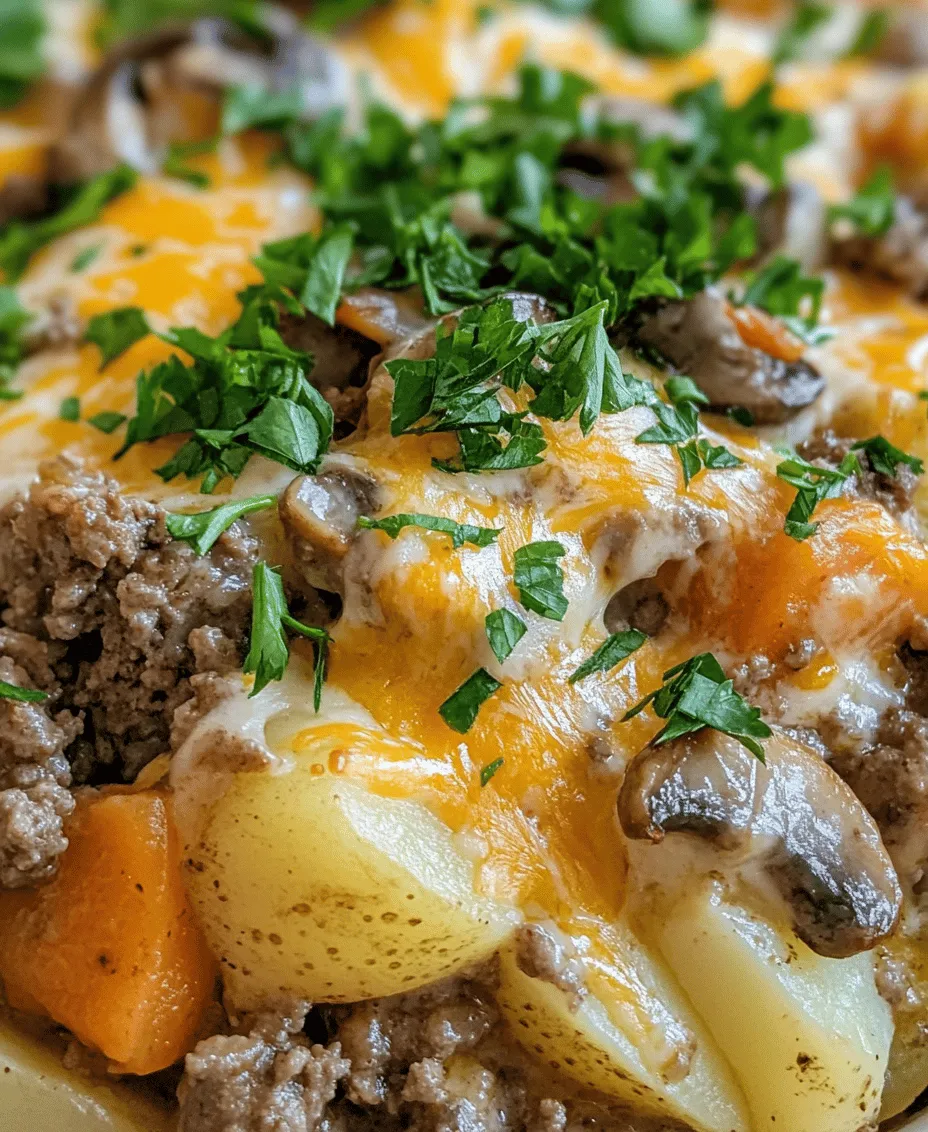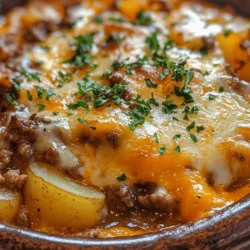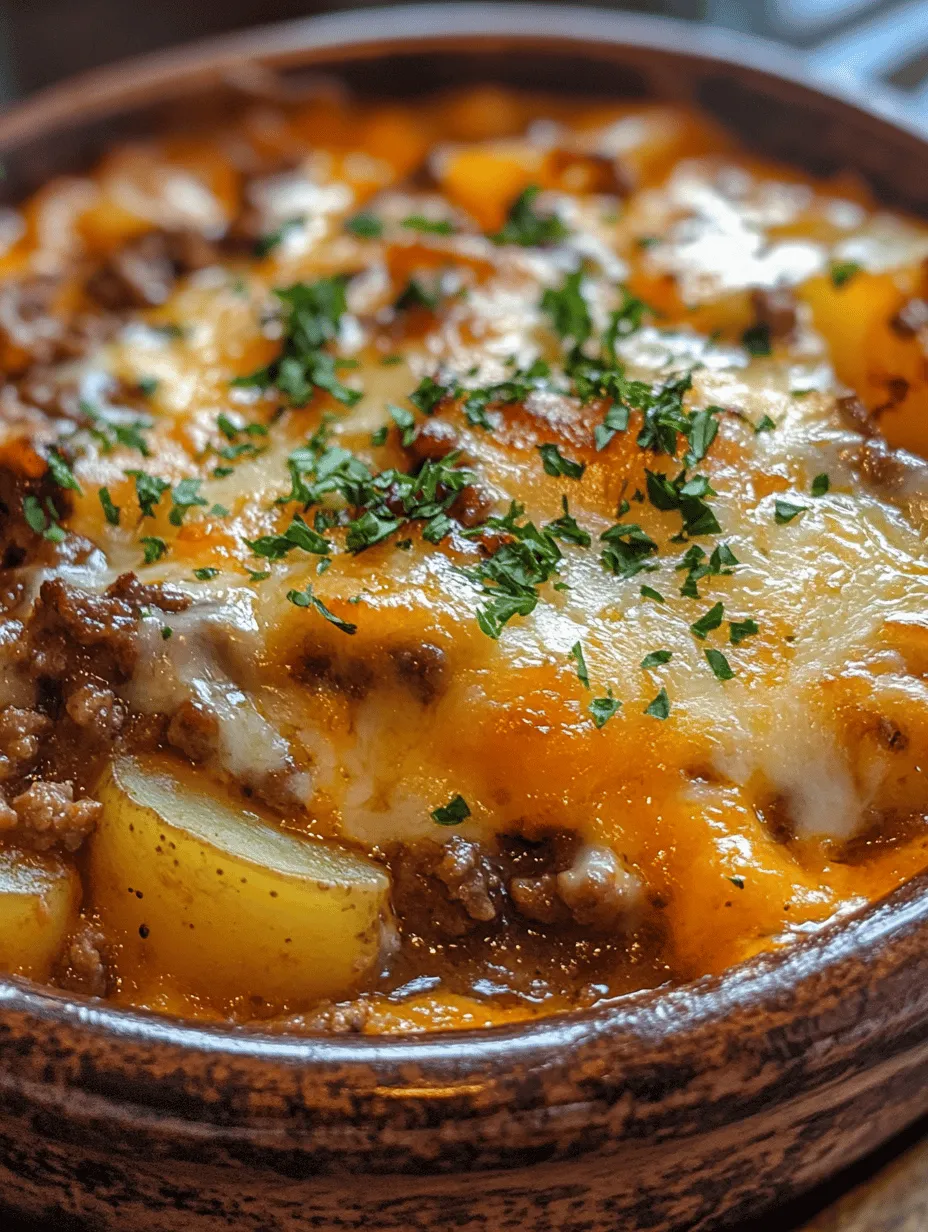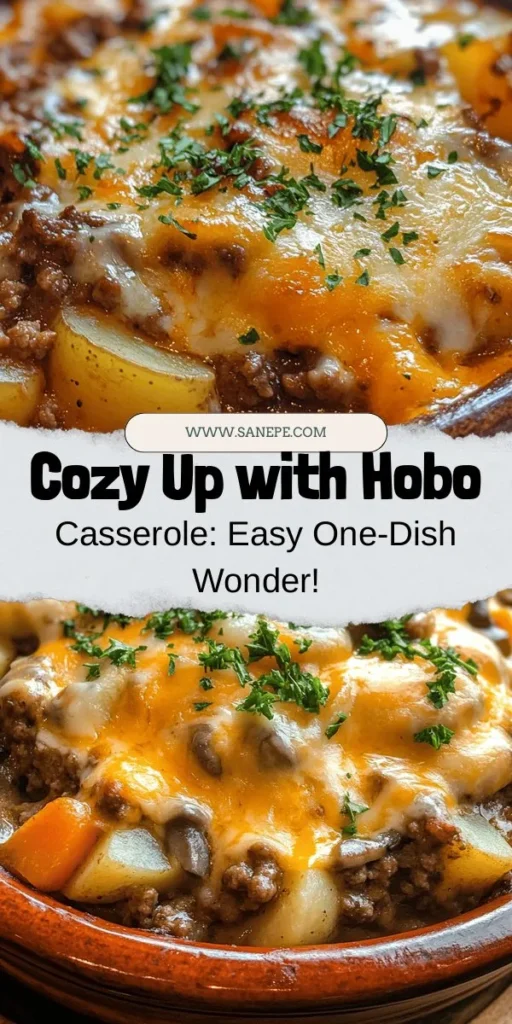Introduction
Hobo Casserole is a cherished dish that embodies comfort food at its finest. With its roots in the Great Depression era, this casserole emerged as a practical meal that brought families together around the dinner table. Its name reflects the spirit of simplicity and resourcefulness, as it was originally created by those looking to stretch their food supplies while still providing a hearty meal. The appeal of Hobo Casserole lies not only in its rich flavors and satisfying textures but also in its ability to adapt to various tastes and preferences, making it a family-friendly option that can please even the pickiest eaters.
In today’s fast-paced world, the importance of ease and convenience in meal preparation cannot be overstated. Hobo Casserole checks all the boxes: it’s easy to prepare, requires minimal cleanup, and can be made with ingredients that are often already on hand. This one-dish wonder allows home cooks to spend less time in the kitchen and more time enjoying the meal with loved ones. Whether you’re preparing a weeknight dinner or a gathering with friends, this casserole is sure to impress and satisfy.
Understanding Hobo Casserole
Definition and Background
Hobo Casserole is a versatile dish typically made with a combination of ground meat, potatoes, vegetables, and a creamy soup base, all baked together until bubbling and golden. Its humble origins are rooted in the need for economical cooking during tough times, where ingredients could be gathered from gardens or local markets without breaking the bank. The dish has since evolved, with countless variations sprouting up across different cultures, each adding unique twists and flavors.
In some regions, Hobo Casserole is made with beans or lentils instead of meat, catering to vegetarian diets while still maintaining that hearty feel. In others, it might include different types of vegetables or spices, showcasing the adaptability of this dish. Regardless of the version, the essence of Hobo Casserole remains the same: a comforting meal that brings people together.
Common Variations and Adaptations
One of the reasons Hobo Casserole has remained a beloved dish over the decades is its inherent flexibility. Home cooks can tailor the recipe to suit their preferences or utilize whatever ingredients they have on hand. Here are a few popular adaptations:
– Vegetarian Hobo Casserole: By substituting ground beef with a mixture of lentils, black beans, or even textured vegetable protein (TVP), this variation retains the heartiness of the original while being plant-based.
– Cheesy Hobo Casserole: Adding different types of cheese, such as mozzarella or pepper jack, can elevate the dish with additional layers of flavor and creaminess.
– Spicy Hobo Casserole: Incorporating jalapeños or hot sauce can give the casserole a kick, making it perfect for those who enjoy a bit of heat in their meals.
These variations highlight why Hobo Casserole is considered a go-to dish for home cooks. It allows for creativity while ensuring that each bite remains delicious and satisfying.
Ingredients Breakdown
When preparing Hobo Casserole, understanding the role of each ingredient can elevate your dish from ordinary to extraordinary. Here’s a detailed breakdown of the essential ingredients in this recipe:
Ground Beef
Ground beef serves as the protein base for the casserole, providing both flavor and heartiness. Not only is it rich in protein, but it also contains essential nutrients like iron and zinc. For those looking for healthier alternatives, lean ground turkey, chicken, or even plant-based ground meat can be used without sacrificing taste.
Onions and Garlic
Onions and garlic are the backbone of flavor in Hobo Casserole. Both ingredients offer a depth of taste that enhances the overall dish. Onions provide sweetness and savory notes, while garlic adds a robust, aromatic quality. Additionally, both ingredients offer health benefits, including anti-inflammatory properties and antioxidants, making them indispensable in any kitchen.
Potatoes
Potatoes are a staple in Hobo Casserole, providing a comforting, starchy base that helps to bind the dish together. Different types of potatoes can be used, such as russets for their fluffiness or Yukon Golds for a buttery flavor. When selecting potatoes, consider their cooking properties; for example, waxy potatoes hold their shape well, while starchy potatoes break down and create a creamier texture.
Mixed Vegetables
The inclusion of mixed vegetables adds nutrition and color to the casserole. You can choose between fresh or canned options, depending on availability and preference. Fresh vegetables like bell peppers, zucchini, or carrots contribute crispness and a burst of flavor, while canned vegetables offer convenience and a longer shelf life. Regardless of your choice, including vegetables ensures a well-rounded dish.
Cream of Mushroom Soup
Cream of mushroom soup acts as the binding agent in Hobo Casserole, providing creaminess and flavor. While many opt for store-bought varieties, making a homemade version can enhance the dish significantly. Homemade soup allows for controlling ingredients, ensuring a healthier and tastier outcome.
Cheddar Cheese
Cheddar cheese is often sprinkled generously over the casserole before baking, creating a gooey, indulgent topping. Different types of cheddar, such as sharp or mild, can be used depending on your flavor preference. The cheese not only adds richness but also creates a delightful golden crust that is hard to resist.
Worcestershire Sauce and Paprika
These two ingredients play a crucial role in elevating the flavor profile of Hobo Casserole. Worcestershire sauce adds a savory depth, while paprika contributes a subtle smokiness that enhances the overall taste. Both ingredients are essential for achieving that signature comforting flavor that makes Hobo Casserole so appealing.
Seasoning
Finally, salt and pepper are the unsung heroes of cooking. Seasoning your casserole properly is vital to bringing out the flavors of all the ingredients. A pinch of salt can make a world of difference, enhancing the natural tastes and ensuring a well-balanced dish.
Preparation Steps for Hobo Casserole
Now that we have a thorough understanding of the ingredients, it’s time to dive into the preparation steps for creating your own Hobo Casserole Extravaganza. Follow this step-by-step guide to achieve the perfect blend of flavors and textures.
Step 1: Preheat Your Oven
Before getting started, preheat your oven to 350°F (175°C). Preheating is essential for ensuring even cooking throughout the casserole, allowing the flavors to meld beautifully while creating a perfect golden top.
Step 2: Brown the Ground Beef
In a large skillet over medium heat, add your ground beef. Use a spatula to break it apart as it cooks, allowing for even browning. Browning the meat thoroughly is key to developing rich flavors, so aim for a nice golden-brown color. As the beef cooks, you may notice some fat accumulating in the pan. Make sure to drain excess fat once the beef is cooked thoroughly to keep your casserole from becoming greasy.
Step 3: Sauté the Onions and Garlic
With the ground beef browned and drained, add diced onions to the skillet. Sauté them for about 3-4 minutes until they become translucent and fragrant. Then, add minced garlic and continue to sauté for another minute. The combination of sautéed onions and garlic will create a fragrant base for your casserole, enhancing the overall taste.
Step 4: Prepare the Potatoes
While the beef and aromatics are cooking, peel and dice your chosen potatoes into small, uniform pieces. This ensures even cooking and allows the potatoes to absorb the flavors of the casserole. If using starchy potatoes, they will break down slightly during baking, creating a creamy texture that complements the dish.
Step 5: Mix Everything Together
Once your beef, onions, and garlic are ready, it’s time to combine all the components. In a large mixing bowl, combine the browned ground beef mixture, diced potatoes, mixed vegetables, cream of mushroom soup, and shredded cheddar cheese. Stir gently to ensure all ingredients are thoroughly combined. This step is critical, as it ensures every bite of the casserole is packed with flavor.
Step 6: Season the Mixture
Don’t forget to season your mixture with salt, pepper, Worcestershire sauce, and paprika. These seasonings will enhance the flavors of the ingredients and create a well-balanced dish. Taste the mixture and adjust the seasoning as necessary to suit your preferences.
Step 7: Transfer to Baking Dish
Once everything is combined and seasoned, transfer the mixture into a greased 9×13-inch baking dish. Spread it out evenly to ensure uniform cooking. At this stage, you can sprinkle additional cheese on top if desired, as it will create a deliciously cheesy crust once baked.
Step 8: Bake
Place the casserole in the preheated oven and bake for approximately 45-50 minutes, or until the potatoes are tender and the cheese is bubbly and golden. During the last 10 minutes of baking, you can cover the dish with aluminum foil to prevent over-browning if necessary.
As your Hobo Casserole Extravaganza bakes, the delightful aroma will fill your kitchen, making it nearly impossible to resist! Enjoy the anticipation of a comforting meal that’s sure to become a family favorite.

Best Practices for Slicing Potatoes for Even Cooking
Slicing your potatoes uniformly is essential for achieving that perfect texture in your Hobo Casserole. Thin slices allow for even cooking, ensuring that every bite is tender and flavorful. When slicing, aim for about 1/8-inch thickness. This thickness provides enough surface area to absorb flavors while allowing the potatoes to cook thoroughly without becoming mushy.
To ensure uniformity, consider using a mandoline slicer or a sharp knife. If using a knife, take your time to maintain consistency; uneven slices can lead to parts of the casserole being undercooked while others become overly soft. Soak the sliced potatoes in cold water for about 30 minutes before layering them into the casserole. This step not only helps to remove excess starch but also prevents browning, resulting in a fresher appearance and texture.
Combining Ingredients: Achieving the Right Texture and Flavor Balance
Creating a well-balanced Hobo Casserole involves combining your ingredients thoughtfully. As you layer your potatoes, be sure to sprinkle in seasonings like salt, pepper, garlic powder, and onion powder between layers. This ensures that every bite is packed with flavor.
Incorporate your choice of proteins, such as ground beef, turkey, or even vegetarian options like beans or lentils, to add heartiness. If using vegetables, consider bell peppers, corn, or peas for color and nutrition. Mixing in a variety of ingredients not only enhances the flavor but also contributes to a pleasing texture. For instance, pairing creamy cheeses with crispy vegetables creates a delightful contrast that elevates the entire dish.
Proper Baking Techniques to Ensure Even Cooking
Baking a casserole requires some attention to detail to ensure that everything cooks evenly and thoroughly. Preheat your oven to 350°F (175°C) before placing your casserole inside. This initial heat ensures that your casserole starts cooking right away, promoting even heat distribution.
When layering your casserole, start with a base of potatoes, then alternate with layers of protein and vegetables. Finish with a generous topping of cheese. If you’re using a glass baking dish, be aware that it may require slightly longer cooking compared to metal pans, which conduct heat more efficiently.
Baking the Casserole
The baking process is crucial in bringing the Hobo Casserole to life. It allows the flavors to meld and the ingredients to soften, creating a harmonious dish. Covering the casserole with foil for the first half of baking traps steam, helping to cook the potatoes and other ingredients thoroughly. After about 30-40 minutes, remove the foil to allow the top to brown and the cheese to melt beautifully.
If you prefer a crispy top, baking uncovered for the entire duration will yield a golden, bubbling surface. Keep an eye on the casserole to avoid burning the edges while ensuring the center cooks through.
How to Know When the Casserole Is Done
Determining doneness is straightforward. The casserole is ready when the potatoes are fork-tender, and the cheese is melted and bubbly. You can pierce the center with a fork; if it slides in easily, you’re in the clear. Additionally, a thermometer can help; the internal temperature should reach 165°F (75°C) to ensure food safety.
The Melting and Bubbling Cheese: Final Touches to the Dish
The final touches of your Hobo Casserole are all about that cheese. As it melts and bubbles, it forms a golden crust that adds both flavor and texture. For the best results, use a blend of cheeses like cheddar, mozzarella, and pepper jack for a mix of creaminess and spice. Consider adding the cheese during the last 10-15 minutes of baking to prevent it from browning too quickly while still achieving that gooey finish.
Serving Suggestions
Hobo Casserole is a complete meal on its own, but pairing it with complementary side dishes can elevate your dining experience. A fresh green salad with a tangy vinaigrette can balance the richness of the casserole, while a side of garlic bread or cornbread offers a comforting touch.
For garnishing, consider adding fresh herbs such as chopped parsley or chives for a pop of color and flavor. A dollop of sour cream or a sprinkle of crunchy fried onions on top can also provide an appealing contrast to the creamy casserole.
When serving, portion sizes can vary based on appetite; however, a generous scoop per person is recommended for family meals. Consider serving it in individual bowls or family-style, allowing guests to help themselves.
Nutritional Information
Understanding the nutritional profile of your Hobo Casserole is important, especially when accommodating dietary needs. A typical serving contains approximately 350-450 calories, depending on the ingredients used. The casserole is also a good source of protein, fiber, and essential vitamins from the vegetables.
For those with dietary considerations, the recipe can easily be modified. To make it gluten-free, simply substitute traditional pasta or breadcrumbs with gluten-free alternatives. For a low-carb option, consider using cauliflower instead of potatoes, creating a delicious cauliflower casserole that still captures the essence of the original recipe.
Storage and Reheating Instructions
Leftovers are one of the best parts of making Hobo Casserole! To store your casserole, allow it to cool completely, then cover it tightly with plastic wrap or transfer it to an airtight container. Properly stored, it will last in the refrigerator for up to 3-4 days. For longer storage, consider freezing the casserole. It can be frozen for up to three months. Just be sure to label the container with the date for reference.
When reheating, the oven is the best method to maintain the casserole’s texture. Preheat your oven to 350°F (175°C), cover the dish with foil, and heat for 20-30 minutes or until warmed through. Alternatively, you can microwave individual portions, heating at medium power in 1-minute intervals until hot.
Conclusion
Hobo Casserole is a delightful, comforting dish that brings warmth and satisfaction to any table. Its simplicity and versatility make it an ideal choice for weeknight dinners, potlucks, or family gatherings. The combination of tender potatoes, flavorful proteins, and melted cheese creates a hearty meal that everyone will love.
With the guidelines provided, you can easily adapt this recipe to suit your taste preferences and dietary needs. Whether you’re enjoying it fresh from the oven or savoring leftovers, Hobo Casserole is sure to become a staple in your cooking repertoire. Don’t hesitate to try it out and experience its deliciousness firsthand!


